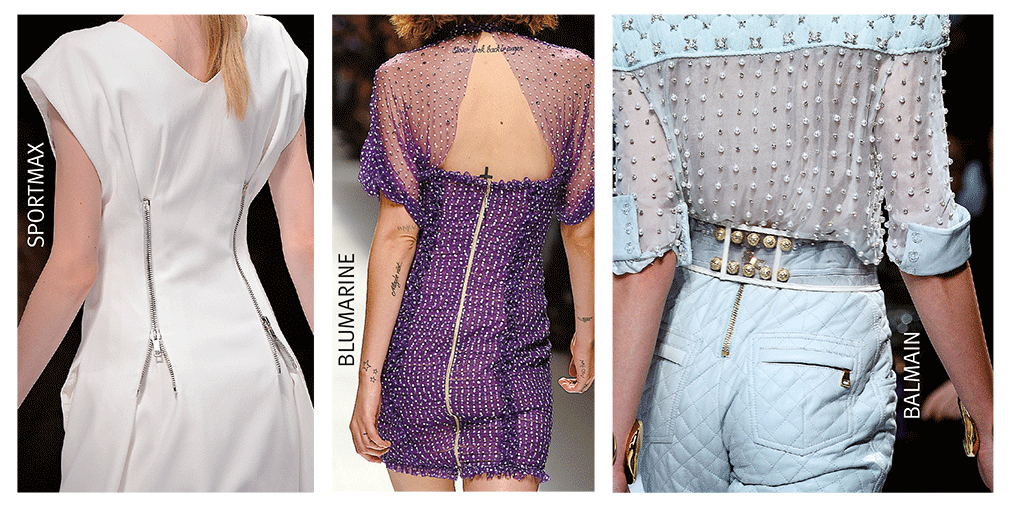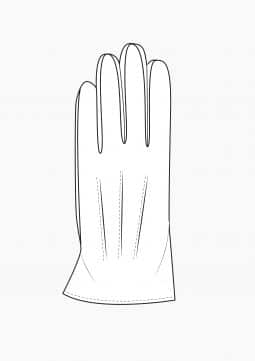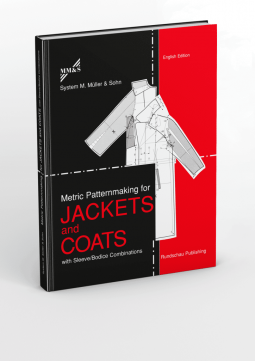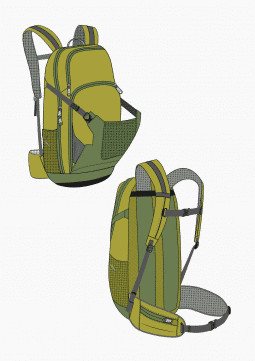The History of the Zipper
Deutsch

Zippers have long since ceased to serve only the purpose of closing and have definitely made their way into the Front Row. The metal teeth ennoble dresses, skirts and tops as design elements, replace chains & Co. It fits skilfully into any styling, be it as an invisible zipper or as a striking design element. There are even no limits to the play of colours. Whether metallic shiny in copper, silver or gold, transparent in nylon, dyed or with the trompe l’oeil effect like Richmond, technically everything is possible with this closure. Who invented the zipper and how it developed over the years to an ingenious everyday object you can learn here.
1851: Elias Howe, USA, received a first patent concerning a closing device consisting of two reinforcements which were sewn into the fabric edges to be joined together. Small metal clamps enclosed the beads on which the clamps were slid longitudinally.

The staples themselves were in turn attached to a narrow cotton band so that there was a two-inch gap between the tabs. If the tabs were pulled apart with the cotton ribbon, the garment was closed. When the tabs were pushed together again, the garment opened. This idea can be described as the first approach to the realization of the zipper.
1890: As early as 1890, Max Wolff, Moscow, invented the spiral zipper we all know. However, due to the lack of suitable materials, these zippers were not widely used until the 1950s after using nylon spirals instead of ones made of steel or metal.

1893: Whitcomb Judson, New York, presented his hook fastener, which is referred to as the “first zipper”. However, as these closing devices opened a lot more than they closed and because they were nearly as expensive as the objects to be closed, the sales were extremely small.


1908: The Swede Gideon Sundback launched his first zipper under the name “Modell Plako” in the USA. Again, success did not materialize – the prospective zealots had not forgotten their experience with the previous closures.
1911: A turning point in the development of the zipper could have come about by a patent, which was registered 1911 in Switzerland by Mrs. Catharina Kuhn-Moos and Mr. Henri Forster. In fact, the classic zipper as we know it was actually born here. Not only that the in the patent drawn zippered links are still predominantly used in their basic form today, even the pusher already shows the basic form, which of course to this day is used with appropriate refinements.
Yet, neither the inventors themselves nor others interested in the patent recognized the true value of this invention. Since no one could be found to acquire a license or the patent itself, after a few years the patent lapsed.

1912: Again, a groundbreaking development took place by Sundback. Whether and to what extent the Kuhn-Moossche patent was influential in this case cannot be determined. The main point of the improvement was to replace the blocks of the Kuhn-Moos RV by lamellas punched out from a metal strip – today the classic metal zippers are still manufactured according to this process.

1924: The St. Gallen inventor Dr. Ing. Martin O. Winterhalter to make a good zipper without violating the patents Sundbacks. His Rinne-Rippe patent laid the foundation for the start of his activities in Germany and in several European countries under the name ri-ri. His great pioneering work was that for the first time he designed fastener types that could be mass-produced. He also developed and built the machine for their fabrication.
1929: One of the most significant innovations in the zipper area was the invention of the die casting process for producing injection molded plastic and metal chains. Having developed this process is a merit of the riri works.
1936: Winterhalter returns to Switzerland due to the political situation in Germany and founds the company riri in Mendrisio.

1945: Rationalization became the all-catching buzzword. Increasingly, metal zippers are made in the “DaB” (wire on tape) process. For this purpose, the staples are punched out of a wire in a single production step and at the same time pressed onto the fabric band. DaB closures usually have a rough surface. The riri-metal-RV are still manufactured in the very elaborate, classical process. Before the staples are pressed onto the strip, their surface is polished and provided with a galvanic treatment (noble appearance, no rough edges, outstanding surface quality).
To date: The different types of zipper are constantly being developed. From 1950 on, the spiral zippers make their inexorable triumph. Plastics are becoming increasingly important. In many areas, they are the best choice in terms of strength and economy. Since the 1980s, cotton ribbons have for the most part been replaced by synthetic ribbons. Nickel was replaced by alternative materials in the 1990s for ecological and health reasons. The needs of the fashion industry require new developments, mainly in the optical sector. Shapely tabs, various metal surfaces or special tapes are becoming increasingly important. The development of splash-proof zippers and other high-tech materials has revolutionized outdoor clothing. Instead of elaborate overlaps waterproof zippers are visibly sewn, glued or welded. riri also develops the AquaZip based on a plastic tooth zipper. Further Optical or technical improvements from various manufacturers are constantly coming onto the market. In summer 2014 even haute couture uses the zipper as a stylistic element.
Instructions for pattern construction and finished patterns for sewing can be found in our online shop.




